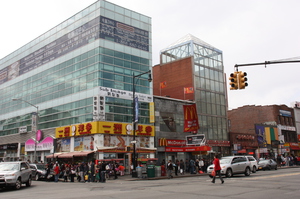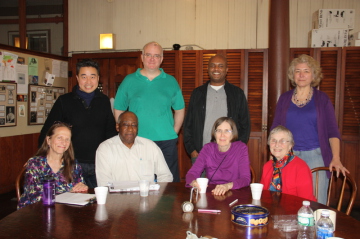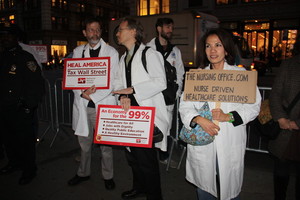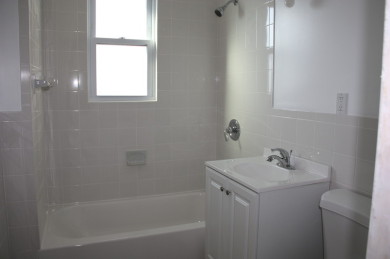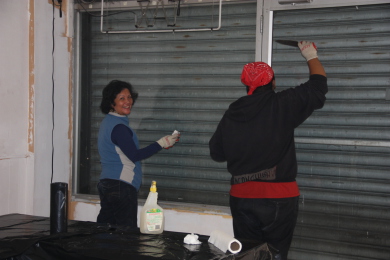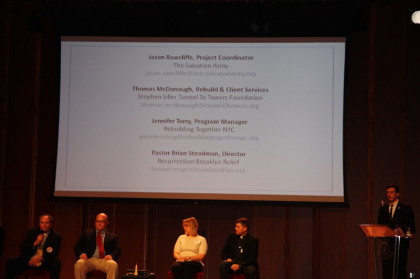WELCOME to GENTLE HAMMERS
NOSTALGIA PROJECT
This is a joint project of The Nursing Office Foundation, Divine Child Foundation and Philippine Community Center Services for Aging, under the Gentle Hammers Housing Solution, to renovate and remodel a 95-year old brickhouse, promoting creativity by integrating a fusion of antique and contemporary designs.
Under the leadership and management of Robert Anthony Santos which started in 2023 and expected completion by 2024.
BACKGROUND
DE BLASIO’S TINY HOUSES PLAN FOR APARTMENTS IN BASEMENTS, GARAGES AND BACKYARDS By Trone Dowd, Reuven Blau and Christine Chung
The de Blasio administration wants to make it easier for homeowners to legally add apartments in basements, atop garages — and even in backyard tiny houses — to boost affordable housing.
The plans, shared Wednesday with THE CITY, entail easing parking requirements as well as supplying low-interest loans to finance construction that would bring the new digs up to code.
“The key to unlocking more housing for New Yorkers is just below our feet,” Mayor Bill de Blasio said in a statement. “Legalizing basement apartments will give homeowners a new way to make ends meet and give thousands of New Yorkers an affordable place to live.”
He’s expected to formally announce the effort Thursday during his State of the City address at the American Museum of Natural History.
Plan Needs Money and Rule Changes
The city plans to set aside $150 million in capital funds for the loans. Zoning changes woud address rules that currently require additional parking spaces for new apartments in many residential areas — action that could take at least two years, the mayor’s office indicated.
De Blasio administration officials expect at least 10,000 safe and affordable units could be added to the housing-starved city within the next decade under the proposed changes, which require City Council approval.
The new dwellings could even include “tiny homes in a backyard,” City Hall officials said, though they didn’t offer details.
The Pratt Center for Community Development estimates that New York City already has as many as 114,000 occupied basement apartments.
Will Spisak of Chhaya Community Development Corporation, a housing advocacy group, said he was “cautiously optimistic” about the new de Blasio plan.
“If this really does allow for easier basement conversion experiences, and allowed folks to create accessory dwelling units on their property, this could be really transformative for a lot of homeowners,” said Spisak, the organization’s director of housing justice.
Crawling in East New York
De Blasio is looking to blaze ahead with this citywide effort even as a three-year pilot program testing the concept is barely off the ground in East New York — and struggling to reach tenants who live in tenuous situations.
Since last July, homeowners in that Brooklyn neighborhood have been eligible to bring basement apartments up to code to legally rent them out, under a measure passed by the City Council and signed by the mayor.
The Basement Apartment Conversion Pilot Program aims to provide small low-interest or forgivable loans to up to 40 eligible low- to middle-income homeowners living in one-, two- and three-family homes to help pay for construction work.
To be okayed by the city Department of Buildings as habitable, the apartments must have a sprinkler system, ventilation and windows, as well as at least two ways to exit in an emergency. Landlords also have to abide by affordable housing rules that cap rents at 30% of a tenant’s income.
After spreading the word across Brooklyn Community District 5, the local group Cypress Hills Local Development Corporation has helped hundreds of interested owners with paperwork.
Restored Homes, an organization advancing affordable homeownership, has already assessed 100 homes and vetted the architects and contractors who will do the upgrades.
“We’ve clearly tapped into this wellspring of interest throughout the community,” said Ryan Chavez, who runs the conversion program for the Cypress Hills Local Development Corporation. “There are just countless stories at this point of homeowners who have told us what the potential of this program holds for them in terms of potentially providing them a financial lifeline.”
The city Department of Housing Preservation and Development will ultimately decide on the final 40 homes for the pilot program. Cypress Hills LDC is looking to have architectural plans approved by the Department of Buildings by the end of the year, Chavez said.
Homeowners Hesitate
Most of those apartments, however, don’t exist yet. Cypress Hills LDC is straining to convince owners who already have tenants illegally living in basement apartments to consider signing up to convert.
Just 10% of the buildings up for consideration already have occupied basements, according to Chavez.
The test’s sponsor, City Councilmember Brad Lander (D-Brooklyn), said he had hoped for more participation involving current renters. “It’s been more homeowners with basements which are not yet occupied, which don’t have someone living in them,” he said.
City officials point out the pilot program provides relocation assistance during construction so that existing tenants can return to a safe newly renovated and legal apartment.
Still, Cypress Hills LDC’s Stephanie Becker said that fears of Department of Buildings enforcement kept some owners on the sidelines.
“Right when the pilot was announced, as we’re going out and saying, ‘We have this new program, we represent the city!,’ there were news reports and articles about DOB cracking down on illegal basement apartments citywide,” she said. “It’s been a bit complicated.”
Low Ceilings, High Costs
Another concern is that ceilings in some already occupied apartments may be too low to meet a seven-foot height cutoff.
“If you’ve got an existing unit and someone’s already living there, to then not let that unit into the program because it’s got a relatively low ceiling rather than making the unit safer seems a penny wise and pound foolish,” said Lander.
Overall cost also is among the reasons homeowners ultimately say no thanks to the opportunity.
“The big one is not feeling comfortable incurring debt,” Chavez said. “Whether they think the city will be too bureaucratic during the process or taking on an additional loan at this point, it’s the main reason people are saying no.”City officials say they’ve already discovered that the current additional parking requirements for new dwellings also was a major barrier to getting the new apartments up to code.Chhaya CDC, which will relocate existing tenants during the conversion process, provide tenant counseling and oversee enforcement of affordable housing rules once tenants move back in, says that they are ready to do their part once the 40 homes are decided on.Spisak noted “the pilot [program] has allowed us to gather a lot of data and information on basement apartments, on the incentives and challenges of homeowners.Referring to de Blasio’s city plan, Spisak added, “That may have played a big role in convincing the city that this is a viable project.”
THE CITY is an independent, nonprofit news outlet dedicated to hard-hitting reporting that serves the people of New York.(Jan 20, 2020)
https://thecity.nyc/2020/02/mayor-aims-for-apartments-in-basements-garages-and-yards.html
Landlords must pay broker fees for rental apartments, state says |
|
Landlords are now required to pay the broker's fee for agents they hire to list apartments, rather than pass costs along to the tenant, according to a new state action that could completely upend the rental market for New York. [Crain's New York Business] Also: The decision was the latest in a long string of recent defeats for the real estate industry, which has seen its power diminished after years of allying itself with Republicans when they were in control in Albany. [The New York Times] |
Mayor de Blasio introduces Outreach NYC
Outreach NYC is a brand new, citywide, multi-agency effort to help homeless New Yorkers across the boroughs. The goal of the initiative is to help unsheltered New Yorkers transition off of the subways and streets and into permanent settings. Mayor Bill de Blasio said in a press release that, “We’ve made significant progress in addressing our city’s homelessness crisis under Turning the Tide — and with Outreach NYC, we’re announcing new steps to take that progress even further.”
De Blasio continued, “We cannot attempt to address this issue in a vacuum. It’s time we all wear one uniform. Outreach NYC is our all-hands-on-deck approach to bring even more people in off the streets.”
Since the initial enhancements shared in August 2019, the city has trained 18,000 city employees. The employees are from five different agencies, including: Department of Sanitation (DSNY), the Department of Health and Mental Hygiene (DOHMH), the Fire Department (FDNY), the Department of Buildings (DOB), and the Parks Department. New York City is also planning on hiring an additional 180 outreach workers, bringing the total to 550. They will be trained on how to use the 311 app and all of its resources to help the homeless community, such as how to submit service requests to homeless individuals, which will be sent to the Joint Command Center, managed by the Department of Homeless Services and NYPD.
According to a press release, here’s a breakdown of progress that’s been made since 2014:
- Helping more than 2,200 individuals off the streets and into transitional and permanent settings since the launch of HOME-STAT in April 2016.
- Tripling the city’s investment in street homeless programs, increasing by more than from approximately $45M in 2013 to more than $140M today.
- Tripling the number of outreach staff canvassing the streets engaging New Yorkers 24/7/365 since 2014, from fewer than 200 to more than 550, with those dedicated staff canvassing the streets every day, building relationships over weeks and months through regular contact and concerted engagement with homeless New Yorkers focused on encouraging them to accept services and transition off the streets.
- Tripling the number of emergency ‘safe haven’ and ‘stabilization’ beds dedicated to serving street homeless New Yorkers citywide since 2014, with hundreds of beds opened during this Administration, bringing the total up from 600 to more than 1,800 today, and hundreds more set to open in the coming years, ultimately increasing the total to 2,100 beds dedicated to serving street homeless individuals and available to HOME-STAT outreach teams in their citywide outreach efforts.
- Building the city’s first-ever by-name list of individuals known to be homeless and residing on the streets to improve delivery of services, with outreach teams now knowing approximately 1,300 street homeless individuals by name and actively engaging another 2,400 individuals encountered on the streets to determine whether they are homeless.
- Increasing joint outreach operations to engage more New Yorkers and offer more supports, including expanding joint outreach operations with partner agencies such as DOHMH, Parks Department, Department of Sanitation, NYPD, and the MTA to address conditions as they occur and provide alternative pathways to permanence.
State of Homelessness in the Big Apple
Dec, 2013, NYC
The increasing statistics of homeless families in NYC is very disturbing, as announced by the US Department of Housing and Urban Development. Advocates for the homeless, including the Coalition for the Homeless, say that a total of 64,000 exist in NYC and that’s very significantly high since the great Depression.
While homelessness is a social issue, it is not as obviously disturbing as in the 70’s and 80’s when the Modern Era of homelessness begun to show in the streets in the form of panhandlers, mentally-ill and bag ladies. Today, homeless men are seen carrying more baggage.
However, as government and non-government organizations provided more shelters and better programs, homelessness and “street people” are not as visible as before. For homeless families with children, the situation is different. When they become homeless, they were moved to emergency shelters. It was the practice of the city to house them in “welfare-hotels”. Currently, these housing solutions evolved into transitional homes until they find permanent homes.
Homelessness is an issue that the government, the church and private not-for profit organizations should put their priorities on. These networks must continue to support food pantries and soup kitchens, transitional housing programs and social services and advocacy services. The solution, advocates and civic leaders say, is the creation of new rent-subsidy programs, a push for new housing geared to low and moderate income people and increasing minimum wage. Federal officials claim that the increase in homelessness is driven by a rise in families who can no longer pay their rent. This problem exists in cities like NY where there is a shortage of affordable housing.
Homelessness was presented in a very particular occasion in the Bible, when Jesus was born in a manger, because Joseph and Mary were strangers in Bethlehem. Similarly, NYC is a Melting Pot of people from all over the world finding home away from home. While the Covenant House, a catholic-run shelter for young people is the “best shelter” despite its 200-bed limit, The Coalition for the Homeless has a catholic background from its founder, Robert Hayes.
The Nursing Office. Org has developed Nurse-Driven Housing Solutions to help and advocate for the poor and homeless through its Gentle Hammers. These programs will not only help ease the homelessness issue but the unemployment problems as well, as it hope to create jobs for the people.
Lived Experiences of Home Foreclosures Consequences on Physical and Mental Health
(Dr. Owusu Kizito’s New Book “Lived Experiences Of Home Foreclosures Consequences On Mental and Physical Health” Is A Researched Work On The Effect Of Home Foreclosures)
The rising rate of home foreclosures which stands at approximately 1 in 92 households in the United States has raised a national alarm. Medical issues account for approximately half of all home foreclosure filings and it appears that approximately 1.5 million American homeowners could lose their homes to foreclosure every year. The qualitative phenomenological study involved investigating the lived experiences of the consequences of home foreclosures on the physical and mental illness of northern New Jersey homeowners. The research questions asked included what were the lived experiences of physical and mental health decline following home foreclosure and how did the participant’s perceive their physical and mental health decline affected their family members? Four core themes were revealed from the study. The four themes included foreclosure process resulting in hospitalization of family and foreclosure associated with the lack of family’s health insurance, family health and the foreclosure process, and foreclosure and the negligence of doctor’s prescription, foreclosure as perceived loss of money and finally homeownership, displacement and housing instability as a reason for depression. The current phenomenological research study of the lived experiences of home foreclosures on twenty-five homeowners in the process of foreclosure has added to the body of knowledge because it highlighted the stressors, reasons, and causes. The study provides a framework for local practitioners and decision makers in identifying the consequences on the physical and mental health of the participants and their families and providing a workable foreclosure response system.
Link In Comment.. 6-24-2015
Dr. Kizi, Congratulations on your new book! I definitely agree on what and how foreclosures impact individual's physical and mental health and that these foreclosures and homelessness should be addressed not only as an individual issue but that which affect families and communities. I want to work on this premise as a guideline for The Nursing Office Gentle Hammers as a Nurse-Driven Housing Solutions. I want to apply these solutions in actuality and be of help not only to those who may be in danger of losing their homes but to those homeowners to be able to maintain home ownership and prevent foreclosures altogether.
Myrna D. Santos, RN
NURSE- DRIVEN HOUSING SOLUTIONS
Our Nurse Driven Housing Solutions are developed for both short and long term goals, bringing several programs together (HR Management, Social Services, etc. ) for collaborative solutions not only for housing but for relieving unemployment as well.
- Advocacy for the Homeless
- Service Assistance to the Homeless
- Affordable Housing Programs
- Assisted Home Living (in the Comfort of your own home)
- Human Resource and Management
- Property Management
- Affordable Real Estate Services
- Home Buying: Understanding Mortgage Terms
- Housing Construction & Development
- Training & Job Creation
- Home Sharing
- Home Ownership
- Foreclosure Assistance
- Energy Efficiency
- Home Safety (Making Homes Safe)
REFERENCES & LINKS
http://www.nyc.gov/html/dfta/html/benefits/housing.shtml
http://www.programsforelderly.com/housing-gen-home-sharing-newyork-foundation.php
RESOURCES:
2014
Construction
Industry
MARKET OUTLOOK
SURVEY
RESULTS
Read the results of the 2014 Construction Industry Market Outlook Survey, developed to collect information regarding current market dynamics and examine trends affecting the construction industry in the regional New York area to help construction companies plan for 2014.
GENTLE HAMMERS in ACTION
HOUSING In the NEWS
|
New Guidance: Ending Youth Homelessness Through a Coordinated Community Response, September 2015 |
|
The United States Interagency Council on Homelessness has set a national goal to prevent and end youth homelessness by the year 2020. This paper provides a preliminary vision for a coordinated community response to achieve this goal. The information draws upon proven strategies to end homelessness for other populations, along with ways to support the unique needs of unaccompanied youth and young adults. For more information, visit: https://peerta.acf.hhs.gov/content/new-guidance-ending-youth-homelessness-through-coordinated-community-response and https://www.usich.gov/goals/youth
|
Geeky Solutions for Affordable Housing
An expert in the nuts and bolts of affordable housing lays out wonky strategies that just might work
By Michael Lappin
New York City is beset with challenges in its affordable-housing policy. Efforts to upzone neighborhoods and mandate affordable units in those areas have been met with skepticism as residents fear that gentrification will outweigh any increased odds of obtaining a low-cost apartment.
Compounding this is the potential shrinking of the city's allocation of tax-exempt bonds, and HUD rules scheduled to be enacted next year that will, in many neighborhoods, reduce the value of the low-income tax credit for building affordable dwellings. Both programs are central to the city's affordable-housing strategy, and, in the words of one observer, calamitous if they are not rectified.
While the politics and policies of these issues are worked through, there are other opportunities independent of these programs that can supplement the building of affordable housing. Low interest rates, armies of small, low-cost builders, and a wide variety of residentially zoned vacant sites are all features of today's housing market. These can be coupled with a rich reservoir of public subsidies (typically in the form of 1% loans), plus real estate tax incentives (assuming the revised 421-a tax break is enacted without mandating artificially high construction wages) to create a broad menu to stimulate building.
Here are a few areas that might be explored:
Increase the use of private financing. Several projects in the pipeline expected to use bonding might work with conventional financing. Rates on midterm financing (10 to 15 years) are about 1.5% to 2% lower than the 30-year city or state tax-exempt housing bonds (about 6% cost to the project). The combination of lower conventional rates, lower closing and transactional costs, and 421-a tax incentives might make many of these projects suitable for private financing, thus freeing up some bond cap. The loss of the "4%" low-income tax credit proceeds, a component of the bonds, may be made up by using the city's low-interest loans (which are also used to supplement bond transactions).
Build on small sites. Many small sites now residentially zoned could, if developed, meet some affordable-housing needs and help loosen the city's housing market. Based on Department of Finance records, the Furman Center at NYU found about 500 vacant sites that have at least 6,000 square feet with a minimum of 60 feet of street frontage. These sites have an estimated potential buildable footage of 7 million to 10 million square feet. Underused institutional sites (religious properties, etc.) may substantially add to that inventory.
With ceilings on what the city would recognize as purchase prices, the city might offer an aggressive program combining low-interest loans and 421-a tax incentives with conventional funds to incentivize small, low-cost builders to develop these sites. Key to this would be creating a streamlined program accessible to small builders similar to the successful Koch-era vacant-building program. It could set affordability levels for initial renters and commit owners to keep all apartments in rent stabilization for the term of the subsidies: 30 years. The program must provide an opportunity for decent financial returns and not require overly restrictive regulatory agreements under the banner of permanent affordability.
Use publicly owned sites. A variation on the above theme might be used in Housing Authority sites or other city-owned property. Here, by varying the purchase prices of small sites, a combination of incomes might be served. By selling a site (or an equivalent ground lease) for the development of moderate-income housing (say for households averaging 120% of the area median income), the proceeds of the sale could be used to subsidize a similar project serving households with lower incomes. Thus, a self-funding program of mixed-income housing can be created.
Leverage real estate values. The continuing increase in value of many city locations may offer additional resources for affordable-housing development and other needed public goods. The recent sale of Peter Cooper and Stuyvesant Town for $5.3 billion arguably vastly increased the value of the development rights of nearby public land. What is the value of those unused rights of the Riis and Lillian Wald houses, located to the south of Stuy Town? Could they be monetized either through their use within their current zoning and/or in their transfer to eligible adjacent sites? Alternatively, could those rights be transferred to high-value receiving areas as is proposed in the Peter Cooper-Stuyvesant Town deal?
These approaches may increase the accessibility of affordable-housing programs to the broader real estate community as well as increase the resources available for such programs. This increased production capacity can be an important supplement to current city and state efforts.
Michael Lappin is a partner at MLappin & Associates and was CEO of the Community Preservation Corp. from 1980 to 2011.
http://www.crainsnewyork.com/article/20151223/OPINION/151229973/geeky-solutions-for-affordable-housing#utm_medium=email&utm_source=cnyb-dailyalert&utm_campaign=cnyb-dailyalert-20151228
Cluster housing for homeless that are heavily scrutinized get $200 million from NYC
Advocates for affordable housing hate it. The mayor’s own chief investigator called for it to be cut back. But so-called cluster housing for the homeless is about to get another $200 million from the de Blasio administration, which is proposing contracts that could run through 2024.
Cluster sites—privately owned apartments leased and overseen by shelter operators—are notorious for filthy and sometimes dangerous conditions, and critics say they exacerbate the housing crisis by sucking up mostly rent-regulated units for temporary use. Before he became the administration’s Human Resources Administration commissioner, Steven Banks said the city was “shooting itself in the foot” by housing homeless people in them.
Now the Department of Homeless Services has proposed four cluster housing contracts in the Bronx and Brooklyn totaling more than $200 million over four and a half years, with an option to extend them four more.
In March, the Department of Investigation issued a blistering report about odious conditions at cluster sites citywide, including at facilities run by two of the organizations soon to win new contracts, Acacia Network and Bushwick Economic Development Corp., known as BEDCO.
“At the time of the inspection, one elevator was broken and stuck on the sixth floor,” the report said of an Acacia site. “The other had a large puddle of urine on the floor.” It noted a broken window with glass strewn across the hallway of the facility for homeless families.
The poor conditions have been corrected, Acacia said in a statement.
The city paid $95 a night, on average, for the Acacia apartments—two to three times what market-rate tenants pay in those neighborhoods, according to the report from Department of Investigations Commissioner Mark Peters.
It cited BEDCO buildings for vermin and 56 outstanding fire, building and housing violations.
Peters recommended at the time that the agency move away from using cluster housing. Standards were higher at city-run, full-service shelters, DOI found, while cluster buildings “routinely ignore basic health and safety measures.”
A de Blasio administration spokesperson said some cluster sites were closed in the wake of the report, and that the new contracts will allow operators access to funding to make needed repairs and improvements. She added that the deals will also allow the city to hold the providers accountable.
In the past, City Comptroller Scott Stringer has held up contracts with owners of violation-riddled properties. Mayoral aides said Stringer’s action ensured that the sites would not be fixed up.
Cluster operators “don’t have the resources and the history and the background to deliver services of the same quality” as well-established nonprofit shelter providers, said Josh Goldfein of Legal Aid’s Homeless Rights Project.
Advocates say they hope the new contracts will not be used in full. The agreements on the table include more than $69 million for BEDCO, $61 million for LCG Community Services, $48 million for Acacia and $29 million for CRF-Cluster Model Program.
“Hopefully they will move enough people out so that they won’t need clusters anymore, and will pay these providers significantly less than what is in these dollar amounts,” Goldfein said.
Giselle Routhier, policy director of Coalition for the Homeless, said the Homeless Services proposal “doesn’t bode well for the commitment” in the agency’s operational plan, released in March, to use fewer cluster sites.
“We think the solution is for the city to aggressively work to phase out the program and revert the units back to permanent housing for the homeless families currently residing there,” Routhier said.
But with record numbers of families in shelters and mounting public concern about street homelessness, the administration can’t afford to live up to those ideals just yet.
“In the short term, they have to keep using these places until they can bring the census down through move-outs,” said Goldfein.
The city has 3,079 units of cluster housing, down 1% from 2014. The administration said it had formed a repair squad that has cleared more than 10,000 violations, or 83%, at inspected shelters.
Correction: The de Blasio administration spokesman cited in this article is female. An earlier version of this article misstated that fact.
A version of this article appears in the December 14, 2015, print issue of Crain's New York Business as "Scandal? What scandal?".
Mayor Bill de Blasio's housing push
They sounded like fighting words: "The city has for decades let developers write their own rules," Mayor Bill de Blasio said of residential builders in a speech last week. But developers are not the mayor's problem—they are his solution: He wants them to build 80,000 affordable and 160,000 market-rate homes by 2024. Big numbers for sure, even if they would merely keep pace with population gains.
Mr. de Blasio's rhetoric was not aimed at builders but at New Yorkers who fear them. He was telling people he is on their side, so when he supports projects where they live, they won't chain themselves to the bulldozers.
We wish him luck. Prejudice against development runs deep among too many city dwellers and cuts across races and classes. Despite the mayor's pontificating about inequality, many constituents believe his rezoning initiatives will price them out of their neighborhoods.
One resident even opposed a 100% affordable project in working-class Sunset Park,
Brooklyn, complaining at a civic meeting that it "smells like gentrification," The New York Times reported.
In his speech last week, Mr. de Blasio blamed high housing costs on developers' "bias toward luxury housing," but he surely knows there was simply not enough housing built to meet rising demand as
the city's quality of life improved. The supply-demand imbalance, not the construction of luxury units, caused housing costs to rise.
The mayor won't dare address the problem by asking Albany to end rent regulation, which perversely limits the overall supply of affordable housing, as economists on both the left and right will affirm. He won't even push to reform the program to relocate tenants who have more space or lower rents than they can justify. Such common-sense solutions are third rails in New York City politics.
He is left with one option to stem the rising cost of housing: Build much more. Only developers can do that, and only the private market can pay for it.
Mr. de Blasio's stated strategy—"adding density to appropriate parts of our city"—is solid. But can he execute? Community opposition is an obstacle; so is red tape, which the mayor vowed to reduce (a promise every mayor makes). Missteps are inevitable—in his speech, for example, Mr. de Blasio called for a massive affordable-housing complex over an active Queens rail yard, only to have Gov. Andrew Cuomo declare an hour later that the largely state-controlled site is "not available."
But our concern is that the mayor and City Council won't have the gumption to give New Yorkers the development they need when they protest it's something they don't want.
Crain’s New York/ Feb 6,2015
REPAIR & REBUILD NYC:
SANDY RECOVERY SYMPOSIUM II
February 27, 2014
Over 350 recovery staff and advocates shared best practices for disaster recovery,including NYC successes and challenges. Updates from government programs,VOAD organizations and partner programs and their practical applications were presented. The schedule was designed to allow participants to network and collaborate accross organizations for the benefit of Sandy Victims, to repair and rebuild NYC after Hurricane Sandy.






